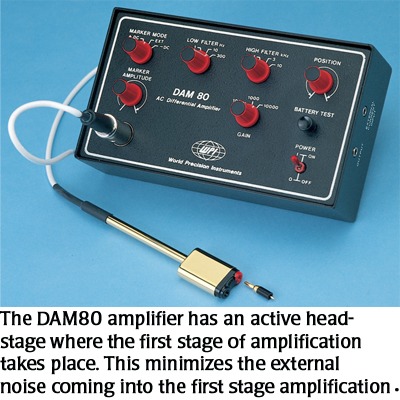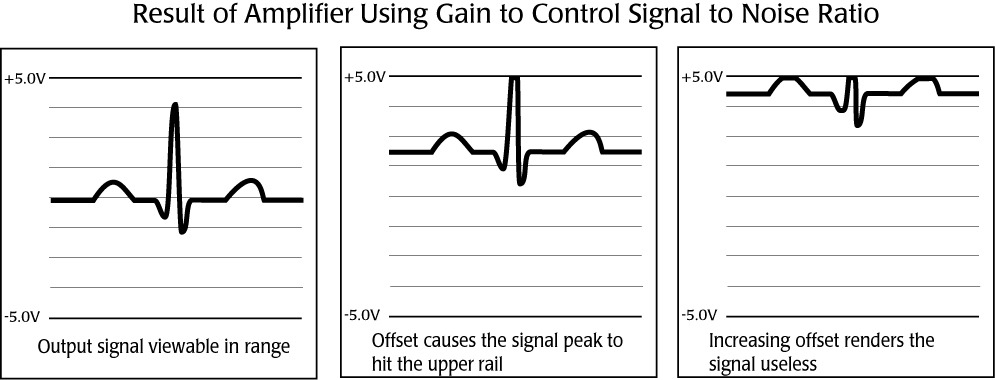 An amplifier, in simplest terms, is an electronic device that magnifies an input signal. However, the way an amplifier is designed to handle noise and bandwidth limitations greatly affects the quality and sustainability of the final output signal.
An amplifier, in simplest terms, is an electronic device that magnifies an input signal. However, the way an amplifier is designed to handle noise and bandwidth limitations greatly affects the quality and sustainability of the final output signal.Defining Terms
To knowledgeably discuss amplifiers, let’s define a few terms.
- Gain – The gain is the multiplier defining how much the amplitude of an input signal is increased. A signal with an X1 gain is not amplified. An X10 gain produces an output signal ten times greater than the input signal.
- Noise – Any unwanted signal fluctuations are called noise. While noise can also result from external sources, for the purpose of this discussion, we are primarily concerned with the noise resulting from the inner workings of the electronic device, our amplifier. This intrinsic noise is called shot (or schott) noise.
- Signal to Noise Ratio (SNR) – The ratio of the output signal to the noise of the amplifier is called the signal to noise ratio. The smaller the shot noise signal in an amplifier in comparison with the output signal, the easier the desired signal is to discriminate. When engineering an amplifier, the SNR may be improved by boosting the first stage gain to yield a larger output signal or by using quality components to minimize the shot noise level of the amplifier.
- Output Range – The output range determines the maximum output signal that can be generated with the amplifier. It is determined by the maximum voltage of the power supply. If the amplitude of the output signal is too large for the output range, part of the signal is cut off (clipped).
- Rail – The upper or lower limit of the amplifier range is called a rail. Signals that exceed the rail cannot be faithfully reproduced.
- DC Offset – DC offsets can appear in biological preparations. This offset is the amount the output signal is displaced away from a zero reference point, and it is usually a result of the potential difference at the electrode’s tip.
How Does an Amplifier Work?
Power Supply Rails Limit the Range
In a perfect world an input signal can be infinitely multiplied by the gain factor to determine the output signal. For example:
| Input Signal | Gain | Output Signal |
| 2mV | X1 | 2mV |
| 2mV | X2 | 4mV |
| 2mV | X10 | 20mV |
| 2mV | X100 | 200mV |
| 2mV | X10,000 | 20V |
In the real world, however, the power supply rails limit the possible output range of the amplifier. For example, a bio-amplifier could have a range of ±5.0V. In order for the output signal to be faithfully reproduced, the input signal times the gain factor must fall within the voltage window set by the power rails. Otherwise, the output signal will go off scale, and the input signal will not be faithfully reproduced. This is called “hitting the rail.”
In our example, a 1.0μV input signal at an X106 gain would generate a 1.0V output signal. Since the power supply is rated up to +5.0V, this output signal is clearly visible. If the input signal in this example is greater than 5.0μV, the output signal would be greater than +5.0V. Since 5.0V is the top of the range that the power supply is capable of producing, the output signal hits the upper rail and gets cut off. This amplifier will give a +5.0VDC output signal for all input signals greater than or equal to 5.0μV. In this instance, a smaller gain factor should be used to bring the output signal back into the dynamic output range of the amplifier.
Noise Limits Amplifier Useability
All electronic devices produce their own internal electronic noise, an unavoidable signal that can mask the output signal. For example, if the input signal is 2mV and the noise is 1mV, the signal to noise ratio is two to one (2:1), and the output signal would be undetectable. In this case, it is nearly impossible to discern which part of the output is generated by noise and which part is the desired signal. (Fig. 1)

Fig. 1–The higher the signal to noise ratio, the more discernable the desired signal.
Ideally, the signal to noise ratio should be at least 50 to 1 to produce a quality output signal. A good signal to noise ratio can be achieved in one of two ways:
- Boost the output signal by increasing the gain.
- Reduce the noise.
While increasing the gain is the simplest solution, too much gain can impose a limitation on the dynamic range of the amplifier. Reducing noise is a more complicated solution, but it offers a greater range and more stability in the end.
Two-Stage Amplifiers
Bio-amplifiers usually involve multiple stages of amplification.
- Stage One – The unadulterated signal coming into the amplifier is unaffected by the intrinsic noise of the amplifier. Then, it runs through the critical first stage of amplification where the signal is boosted by the primary gain factor to produce an output signal with the desired signal to noise ratio. The intrinsic noise is not amplified in the first stage. Higher gain factors used in the first stage of amplification can seriously limit the dynamic range available at output stage. Large stage one gains also limit the gain factor available in the second stage of amplification.
- Stage 2 – The stage one output signal enters the second stage of amplification where both the signal and the noise from the first stage are amplified together by the second stage gain factor so that the signal is large enough to be seen on a chart recorder or data acquisition system. The second stage amplification is the gain the user controls. It does not change the signal to noise ratio.
Instead of using high gains in the first stage of amplification, a well constructed bio-amplifier that uses high quality components, like WPI’s DAM series amplifiers, minimizes the noise in the first stage of amplification so that the dynamic range is retained throughout the amplification process. A poorly designed amplifier will simply increase the gain of the first stage amplification until the desired signal to noise ratio is reached.
Why not Boost the Power Rails?
Theoretically, increasing the voltage rails powering the amplifier will increase the available dynamic output range. It would seem natural to increase the power supply rails coming into the amplifier in order to provide the capability for greater first stage gains. However, most data acquisition systems are limited to a maximum input signal ranging between ±10.0V. Therefore, it is not practical to increase the power rails of bio-amplifier beyond ±10.0V. Since the industry standard limits us to ±10.0V power supply rails, the only way to improve the signal to noise ratio is to minimize the shot noise in the first stage of amplification. This is why high quality amplifier components are imperative.
Why Does My Signal Flatline?
Regardless of the amplifier used, biological potentials are often accompanied by a DC offset, because the electrodes polarize over time. The DC offset naturally increases over time. Since the poorly constructed amplifier that utilizes greater first stage gain has restricted its dynamic range, it has limited ability to handle this offset. As the offset continues to increase, the output signal may eventually be forced by the offset into the rail causing the flat line (clipping the signal). (See Fig. 2.)

Fig. 2–As the offset naturally increases over time, a poorly constructed amplifier will not be able to faithfully reproduce the signal. This offset can also be a result of gain drift which can occur as the temperature rises.
The amplifier that minimizes the noise in the first stage amplification offers a larger dynamic output range and handles a much greater offset value.
WPI’s Amplifiers
The purchase of a low-noise amplifier pays dividends in the end. WPI’s amplifiers were engineered for the bio-medical researcher. While 20-30μV of noise is common in bio-amplifiers, WPI’s DAM series amplifiers generate 0.4μV RMS (root mean squared) at 0.1-100Hz. (That’s equal to about 2μV peak to peak.) The chart below compares WPI’s bio-amplifiers.
|
Amplifier |
AC/DC |
Differential |
Headstage |
EMG |
Stimulation |
Isolated |
Multi- |
Battery |
Connectors |
|
Intracellular Bioamplifiers |
|||||||||
|
DC |
• |
• |
|
|
|
2 |
|
2 mm pin |
|
|
DC |
Use two 705’s for differential measurments |
• |
|
|
|
|
• |
2 mm pin |
|
|
DC |
• |
• |
|
• |
|
2 |
|
2 mm pin |
|
|
Extracellular Bioamplifiers |
|||||||||
|
DC |
• |
opt |
• |
|
• |
1-8* |
|
Mini Banana or 8-pin DIN |
|
|
AC |
• |
• |
• |
• |
• |
|
• |
Mini Banana |
|
|
AC/DC |
• |
|
• |
|
|
|
• |
RJ-11 |
|
|
AC |
• |
• |
• |
• |
|
|
• |
Mini Banana |
|
|
Transducer Amplifiers |
|||||||||
|
DC |
• |
|
|
|
|
1-8* |
|
8-pin DIN WPI transducers |
|
|
DC |
• |
|
|
|
|
4 |
|
8-pin DIN WPI transducers |
|
* 1-8 ISODAM8A or BRIDGE8 units can be combined as separate channels in a single ISDB.





Request
Catalogue
Chat
Print